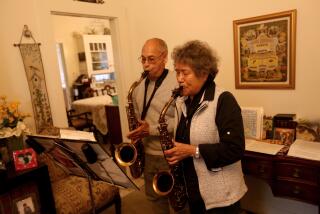Book review: ‘Emily, Alone’ by Stewart O’Nan

- Share via
Emily, Alone
A Novel
Stewart O’Nan
Viking: 255 pp., $25.95
Stewart O’Nan’s books are not about poverty, life’s crises, gross injustice or family drama; in fact, there’s very little drama in his works. He has become a spokesperson — in modern fiction — for the regular person, the working person, and now, the elderly. One of the most beautiful, unforgettable scenes in any novel I’ve ever read occurs in “Last Night at the Lobster,” in which O’Nan describes the manager of a mall-style restaurant switching on the lights at the start of a new day, so full of purpose and hopefulness. This is a writer who illuminates moments like that one, moments you never even noticed.
“Emily, Alone” is O’Nan’s 13th novel, and he has thrown himself into the daily life of an elderly woman using all his interest and empathy. There is nothing pathetic about Emily; she is financially secure in the home in which she raised her two children; she is healthy; she is cultured and intelligent, and she has good relationships with her children and her four grandchildren. (“Good” wounds, meaning everyone is speaking, have healed and Emily can divide property and go quietly when the time comes.)
But life has narrowed down to a very small radius: Her husband is long dead, she spends time with her equally elderly sister-in-law, Arlene, and her children visit twice a year. Emily has a dog, but he is not much company. She listens to classical music and does the New York Times crossword puzzle. Every so often she goes with Arlene to the local diner, the Eat ‘N Park, for a buffet special or to “the club” for a holiday meal when her family is not available. She does not complain. In fact, when the grandchildren do visit, she is often secretly appalled at their insular lack of concern for the people around them. She understands all too well and without dread that she is slipping away from the world. “Lying there with the false hour glowing over her shoulder, she reflected on the arbitrary, changeable nature of time, and how, at her age, she was almost free of it. The idea pleased her, as if she’d discovered something elemental.”
The relationship that most worries Emily is that which she has with her daughter, Margaret, who has battled alcoholism and been in and out of relationships and financial problems her entire adult life. Emily wonders, like any mother, what she might have done differently. But in these last years before death, she finds a kind of balance and peace with even this, her life’s greatest concern.
Why should we care about this character? Because we are all headed in the same direction, and most media make it look pretty bad. It is surprising how often a character as well drawn as Emily lodges in a reader’s imagination and gives us a kind of role model. (If characters in novels in general are very well drawn, 20 years after reading the book, you can scratch your head unable to remember if that was someone you knew in three dimensions or less.)
What’s truly thrilling here is the restraint and respect with which O’Nan cradles Emily’s life. He pays acute attention to how difficult it is to drive as one gets older. He notes the number of memorial services that Emily attends and the importance of every little communication (including bored impatience and polite formality) from family. He describes how carefully the small pleasures in a day are meted out, rationed. Thank-you notes, which splinter between generations (is it really so difficult to thank grandma for the $25?).
O’Nan’s thoroughness is like a skill from another time — a quieter time, when it was easier to listen.
Salter Reynolds is a Los Angeles writer.
More to Read
Sign up for our Book Club newsletter
Get the latest news, events and more from the Los Angeles Times Book Club, and help us get L.A. reading and talking.
You may occasionally receive promotional content from the Los Angeles Times.










